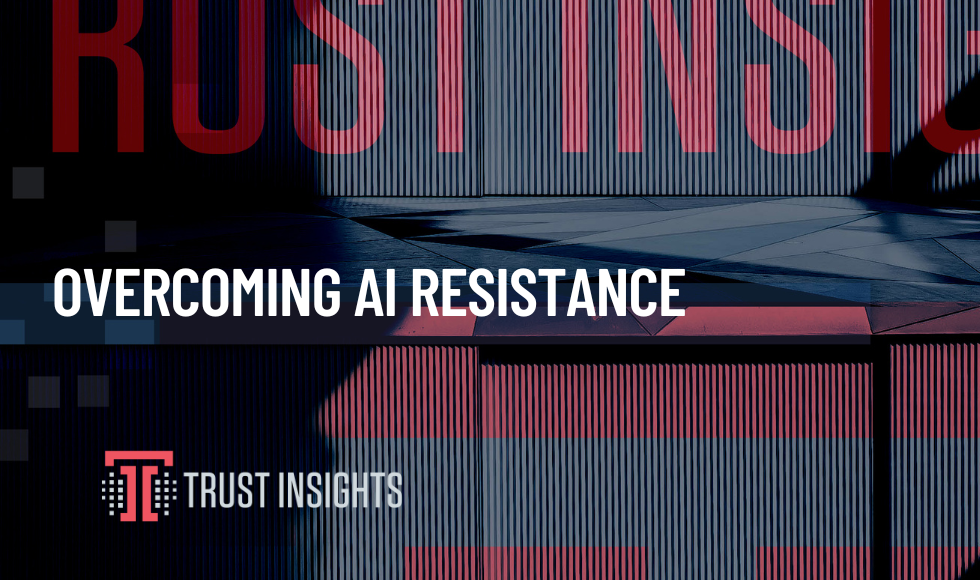This content was originally featured in the September 18th, 2024 newsletter found here: INBOX INSIGHTS, September 18, 2024: Overcoming AI Resistance, OpenAI o1 Model
Catch the replay of our MAICON talks!
How to Overcome Resistance to AI Integration in Your Organization
At MAICON last week, I talked about managing the people who manage AI. In this talk, I mentioned that AI integration is not a digital transformation. It’s a culture shift. A culture shift means that your team, your people, need to change. That’s not an easy ask.
Adopting new technologies, especially AI, can be a tough sell within an organization. People tend to resist change—whether it’s fear of job loss, discomfort with new tools, or concerns about losing the human touch. But the good news is that, with the right strategies, you can turn that resistance into enthusiasm for innovation.
Understand the Root Cause of Resistance
Resistance to change, especially AI, often stems from a few fears: job loss, a lack of understanding, and anxiety over its impact on creativity and decision-making. If you’re hearing hesitation in your organization, take the time to listen and understand the specific fears. This is key. You have to really hear what people are saying. I’ve often found that even if they know it won’t change things, people still want to be heard. They want to know that their voice matters. If you don’t take the time to hear your people out, you will not be able to effect change. AI is a culture shift. You’re asking people to do something new and different. There is bound to be resistance.
Communicate the Benefits in Their Language
It’s easy to talk about AI in terms of its efficiency, but not everyone will see that as a positive. Tailor the messaging to the specific needs of each department. For marketing, highlight how AI can provide deeper customer insights, making campaigns more targeted. For operations, emphasize increased efficiency and reduced human error. It’s not about replacing people, but rather how to make their work product better and give them time to do more high value tasks. Keep the conversation about the people, not the technology.
Provide Education and Training
One of the most significant reasons for pushback is a lack of understanding. If your team doesn’t know what AI does or how it works, they’re less likely to feel comfortable using it. Run training sessions, webinars, or quick tutorials on AI. This will help your team get comfortable with new tools. You can also ask neutral third parties (like me!) to help with education.
You can also invest in courses, like Generative AI for Marketers
Start Small, Show Quick Wins
You don’t need to overhaul your entire business overnight. Start with small, low-risk projects where AI can clearly demonstrate its value. Maybe it’s automating a repetitive task that everyone dreads or enhancing a process that’s already working well. Once you have some quick wins under your belt, you’ll find it easier to build trust and reduce skepticism. Small victories that the teams can feel good about will go a long way.
Involve Key Players in the Process
If you want widespread buy-in, you’ll need the support of your internal champions. Identify key influencers—department heads and respected team members—and get them on board early. When your culture carriers support change, you’ll have an easier time getting others on board. People look to their peers and leaders for cues. Getting your “influencers” excited about AI can help you shift the broader mindset.
Emphasize AI as a Collaborative Tool
One of the biggest misconceptions about AI is that it’s here to take over. In reality, AI is a partner that helps with tasks like data analysis, automation, and analysis. By reframing AI as a collaborative tool that complements creativity and decision-making, you can reduce fear and build enthusiasm. It’s like having a really capable assistant at all times. AI isn’t here to replace anyone. It’s here to help them do their jobs better.
Overcoming resistance to AI integration is about more than pushing a new tool. It’s about understanding and addressing your team’s concerns, educating them, and demonstrating value. By starting small, involving key players, and communicating benefits in a way that resonates, you can mitigate concerns and anxieties.
Change is a marathon, not a sprint. With patience and persistence, you can lead your organization through a successful culture shift and integrate AI into your daily workflow.
Are you meeting resistance from your teams about using AI? Reach out and tell me, or come join the conversation in our free Slack Group, Analytics for Marketers.
– Katie Robbert, CEO








